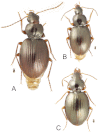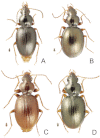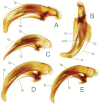New Mecyclothorax spp. (Coleoptera, Carabidae, Moriomorphini) define Mont Mauru, eastern Tahiti Nui, as a distinct area of endemism
- PMID: 23166465
- PMCID: PMC3487650
- DOI: 10.3897/zookeys.227.3797
New Mecyclothorax spp. (Coleoptera, Carabidae, Moriomorphini) define Mont Mauru, eastern Tahiti Nui, as a distinct area of endemism
Abstract
Seven species of Mecyclothorax Sharp precinctive to Mont Mauru, Tahiti, Society Islands are newly described: Mecyclothorax tuteisp. n., Mecyclothorax tihotiisp. n., Mecyclothorax putaputasp. n., Mecyclothorax toretoresp. n., Mecyclothorax anaanasp. n., Mecyclothorax pirihaosp. n., and Mecyclothorax porosp. n. These seven constitute the first representative Mecyclothorax species recorded from Mauru, and their geographic restriction to this isolated massif defines it as a distinct area of endemism along the highly dissected eastern versant of the Tahiti Nui volcano. Each of the new species has a closest relative on another massif of Tahiti Nui, supporting speciation associated with vicariance caused by extensive erosional valley formation, especially the development of Papenoo Valley. Comparison of the known elevational distributions of the new discoveries on Mont Mauru to the elevational diversity profile of the comparatively well-sampled Mont Marau, northwest Tahiti Nui, suggests that numerous Mecyclothorax species remain to be discovered in higher-elevation habitats of Mont Mauru.
Keywords: French Polynesia; allopatric speciation; biodiversity; biogeography.
Figures









Similar articles
-
The first precinctive Carabidae from Moorea, Society Islands: new Mecyclothorax spp. (Coleoptera) from the summit of Mont Tohiea.Zookeys. 2012;(224):37-80. doi: 10.3897/zookeys.224.3675. Epub 2012 Sep 29. Zookeys. 2012. PMID: 23129989 Free PMC article.
-
The Mecyclothorax beetles (Coleoptera, Carabidae, Moriomorphini) of Haleakala-, Maui: Keystone of a hyperdiverse Hawaiian radiation.Zookeys. 2015 Dec 11;(544):1-407. doi: 10.3897/zookeys.544.6074. eCollection 2015. Zookeys. 2015. PMID: 26798289 Free PMC article.
-
The Mecyclothorax beetles (Coleoptera, Carabidae, Moriomorphini) of Tahiti, Society Islands.Zookeys. 2013 Aug 9;(322):1-170. doi: 10.3897/zookeys.322.5492. eCollection 2013. Zookeys. 2013. PMID: 24003312 Free PMC article.
-
Biogeography of the fauna of French Polynesia: diversification within and between a series of hot spot archipelagos.Philos Trans R Soc Lond B Biol Sci. 2008 Oct 27;363(1508):3335-46. doi: 10.1098/rstb.2008.0124. Philos Trans R Soc Lond B Biol Sci. 2008. PMID: 18782725 Free PMC article. Review.
-
Biogeography and speciation of terrestrial fauna in the south-western Australian biodiversity hotspot.Biol Rev Camb Philos Soc. 2015 Aug;90(3):762-93. doi: 10.1111/brv.12132. Epub 2014 Aug 15. Biol Rev Camb Philos Soc. 2015. PMID: 25125282 Review.
Cited by
-
The first precinctive Carabidae from Moorea, Society Islands: new Mecyclothorax spp. (Coleoptera) from the summit of Mont Tohiea.Zookeys. 2012;(224):37-80. doi: 10.3897/zookeys.224.3675. Epub 2012 Sep 29. Zookeys. 2012. PMID: 23129989 Free PMC article.
-
The Mecyclothorax beetles (Coleoptera, Carabidae, Moriomorphini) of Haleakala-, Maui: Keystone of a hyperdiverse Hawaiian radiation.Zookeys. 2015 Dec 11;(544):1-407. doi: 10.3897/zookeys.544.6074. eCollection 2015. Zookeys. 2015. PMID: 26798289 Free PMC article.
-
The Mecyclothorax beetles (Coleoptera, Carabidae, Moriomorphini) of Tahiti, Society Islands.Zookeys. 2013 Aug 9;(322):1-170. doi: 10.3897/zookeys.322.5492. eCollection 2013. Zookeys. 2013. PMID: 24003312 Free PMC article.
References
-
- Arndt E. (1998) Phylogenetic investigation of Carabidae (Coleoptera) using larval characters. In: Ball GE, Casale A, Vigna Taglianti V. (Eds) Phylogeny and classification of Caraboidea (Coleoptera: Adephaga). Proceedings of a symposium (28 August, 1996, Florence, Italy). 20 International Congress of Entomology, Atti Museo Regionale di Scienze Naturali (Museo Regionale di Scienze Naturali–Torino, Torino), 171–190.
-
- Becker M, Brousee R, Guille G, Bellon H. (1974) Phases d’érosion—comblement de la vallée de la Papenoo et volcanisme subrécent à Tahiti, en relation avec l’évolution des îles de la Société (Pacifique Sud). Marine Geology 16: M71–M77. doi: 10.1016/0025-3227(74)90064-4 - DOI
-
- Bousquet Y, Goulet H. (1984) Notation on primary setae and pores on larvae of Carabidae (Coleoptera: Adephaga). Canadian Journal of Zoology 62: 573–588. doi: 10.1139/z84-085 - DOI
-
- Britton EB. (1938) Carabidae of the Society Islands and Rapa (Coleoptera). Occasional Papers of Bernice P.Bishop Museum 14: 103-110.
-
- Craig DA, Currie DC, Joy DA. (2001) Geographical history of the central–western Pacific black fly subgenus Inseliellum (Diptera: Simuliidae: Simulium) based on a reconstructed phylogeny of the species, hot–spot archipelagoes and hydrological considerations. Journal of Biogeography 28: 1101–1127. doi: 10.1046/j.1365-2699.2001.00619.x - DOI
LinkOut - more resources
Full Text Sources
Miscellaneous
